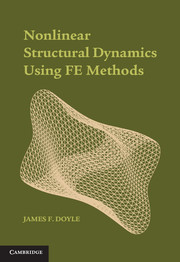8 - Vibration of Plates and Shells
from PART II - DYNAMIC ANALYSES
Published online by Cambridge University Press: 05 October 2014
Summary
A plate is an extended body where one of the dimensions is substantially smaller than the other two. The plates in three-dimensional (3D) thin-walled structures (called shells and folded-plate structures) can support both in-plane and out-of-plane loading. Furthermore, because the plates are thin, they lend themselves to approximation – while the structure may be three-dimensional, the local behavior is two-dimensional under plane stress. Plates in flexure are the two-dimensional equivalent of beams, and classical plate theory is the equivalent of the Bernoulli-Euler beam theory, whereas the in-plane or membrane behavior of plates is analogous to that of rods. We consider both of these separately.
We first develop the strong formulation for plates and present their spectral forms. It turns out, however, that very few strong-form solutions are available for arbitrary BCs, but there is one class with periodic BCs where very useful results can be obtained. We concentrate on these.
Flexural Behavior of Flat Plates
We develop a thin-plate model (called classical plate theory) that does not take the transverse shear deformation into account – this is therefore the plate counterpart of the Bernoulli-Euler beam. We could develop a model (called the Mindlin plate theory) that takes the shear deformation into account; however, it is worth keeping in mind that if shear effects in the plate might be important, then the plate should be modeled using the 3D solid Hex20 element.
Information
- Type
- Chapter
- Information
- Nonlinear Structural Dynamics Using FE Methods , pp. 427 - 486Publisher: Cambridge University PressPrint publication year: 2014
